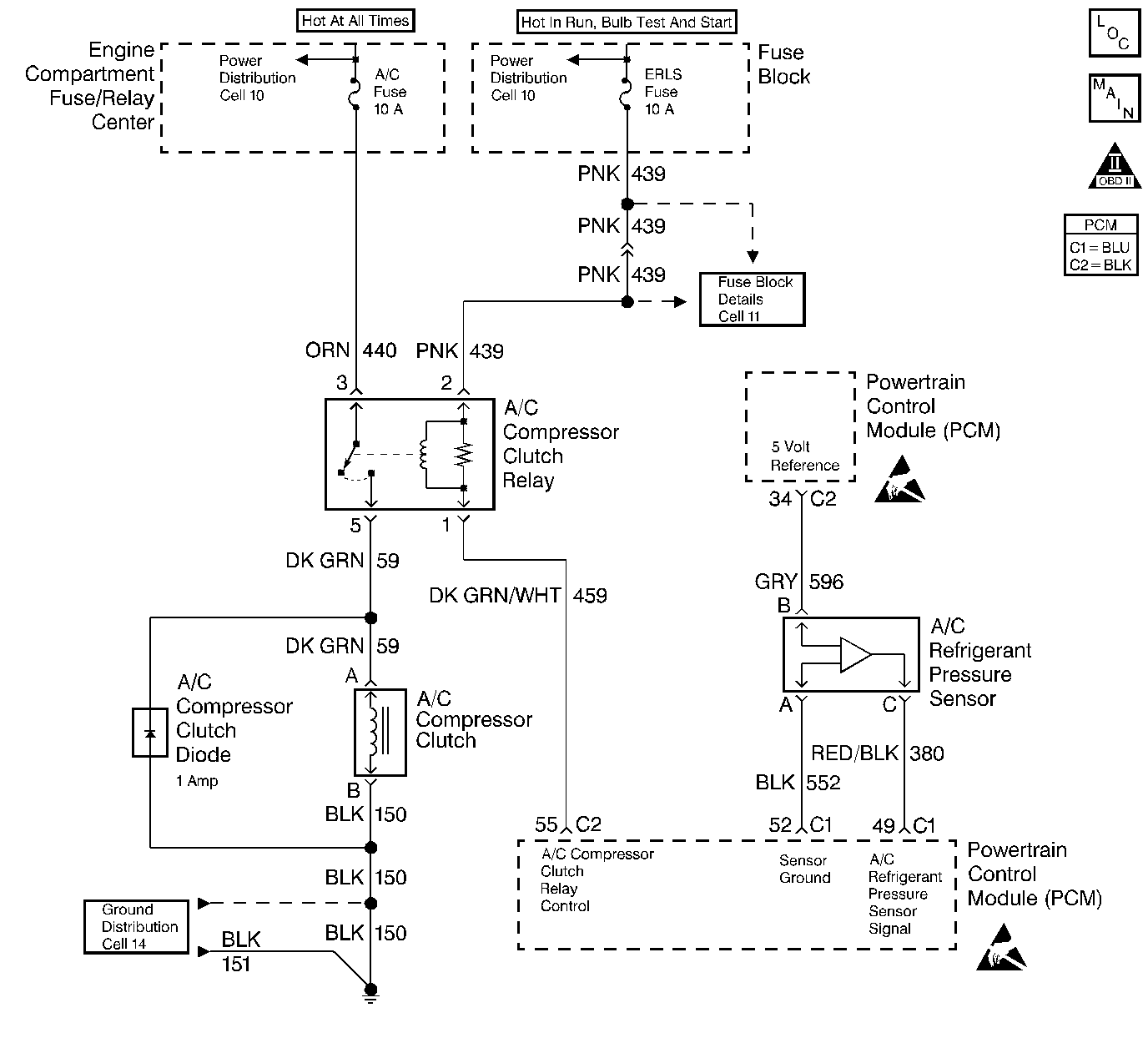
Circuit Description
The air conditioning (A/C) refrigerant pressure sensor responds to the changes in the A/C refrigerant high side pressure. This input indicates how much load the A/C compressor is putting on the engine, and is one of the factors used by the Powertrain Control Module (PCM) in order to determine the idle air control (IAC) position for the idle speed. The circuits consist of a 5 volt reference and a ground, both provided by the PCM, and a signal from the sensor. The signal is a voltage which is proportional to the A/C pressure. The sensor's operating range is between 0 and 459 psi. At 0 psi, the signal voltage will be approximately 0.1 volt, varying to approximately 4.9 volt at 459 psi.
Conditions for Running The DTC
The A/C refrigerant sensor pressure is more than 453 psi (4.92 volt) with the A/C requested.
OR
The A/C refrigerant sensor pressure is more than 363 psi (3.98 volt) with the A/C not requested.
OR
The A/C refrigerant pressure sensor is less than 0 psi (0.20 volt) when the intake air temperature is more than 0°C (32°F) and DTC P0112 or P0113 is not set.
OR
The A/C refrigerant sensor pressure is less than 0 psi (0.20 volt) when an IAT sensor DTC is present or IAT is less than 0° C (32° F).
Conditions for Setting the DTC
Any of the above conditions are met for 15 seconds.
Action Taken When the DTC Sets
| • | The PCM will record the operating conditions at the time during which the diagnostic fails. This information will store in the Failure Records buffer. |
| • | A history DTC stores. |
| • | The PCM will disable the A/C compressor clutch. |
Conditions for Clearing the MIL/DTC
| • | A history DTC will clear after 40 consecutive warm up cycles without a fault. |
| • | Use a scan tool to clear the DTCs. |
Diagnostic Aids
| • | The DTC P0530 sets when the signal voltage is outside of the normal possible range of the sensor. |
| • | If the actual pressure of the A/C system matches the scan tool readings, repair any A/C pressure problems before using this table. Refer to the Air Conditioning System section of the service manual. |
| • | Thoroughly check any suspected circuitry for the following conditions: |
| - | Backed-out terminals |
| - | Improper mating of the terminals |
| - | Broken locks |
| - | Improperly formed or damaged terminals |
| - | Faulty terminal-to-wire connections |
| - | Physical damage to the wiring harness |
Test Description
The numbers below refer to the step numbers on the Diagnostic Table.
-
This step determines if the fault is present or if it is an intermittent fault.
-
This step determines if the fault is an electrical fault or a refrigerant pressure fault.
Step | Action | Value(s) | Yes | No |
|---|---|---|---|---|
1 | Did you perform the Powertrain On-Board Diagnostic (OBD) System Check? | -- | ||
Is the A/C pressure sensor reading within the specified values? | 0-450 psi | |||
3 |
Does the scan tool indicate that this diagnostic failed this ignition? | -- | Go to Diagnostic Aids. | |
4 | Use a scan tool to check for other DTCs. Are any manifold absolute pressure (MAP) or throttle position (TP) codes set? | -- | Go to the Applicable DTC table. | |
Does the A/C manual gauge high side reading agree with the scan tool A/C pressure sensor reading within the tolerance value listed? | 20 psi | Go to Function Test in Heating, Ventilation and Air Conditioning | ||
6 | Monitor the A/C pressure reading on the scan tool. Does it indicate an A/C pressure sensor reading of 0 psi or less? | -- | ||
7 | Disconnect the A/C pressure sensor electrical connector. Does the scan tool indicate an A/C pressure of less than the specified value? | 76 psi | ||
8 |
Does the scan tool indicate an A/C pressure sensor reading near the specified value? | 450 psi | ||
9 | Connect a DMM between the A/C Pressure sensor connector 5-volt reference circuit and a known good ground. Is the voltage near the specified value? | 5V | ||
10 | Check the A/C pressure sensor 5-volt reference for an open or short to ground. Did you find a problem? | -- | ||
11 | Check the A/C pressure sensor ground circuit for an open or faulty connection. Did you find a problem? | -- | ||
12 | Check the A/C pressure sensor signal circuit for an open or short to ground. Did you find a problem? | -- | ||
13 | Check the A/C pressure sensor signal circuit for a short to voltage. Did you find a problem? | -- | ||
14 | Repair the circuit as necessary. Refer to Wiring Repairs or Connector Repairs in Wiring Systems. Is the action complete? | -- | -- | |
15 |
Did you find and repair the condition? | -- | -- | |
16 | Replace the A/C pressure sensor. Refer to Air Conditioning (A/C) Refrigerant Pressure Sensor Replacement in Heating, Ventilation and Air Conditioning. Is the action complete? | -- | -- | |
17 |
Important: Refer to Powertrain Control Module Replacement/Programming . Replace the PCM. Refer to Powertrain Control Module Replacement . Did you complete the replacement? | -- | -- | |
18 |
Does the scan tool indicate that this diagnostic has run and passed? | -- | ||
19 | Select the Capture Info option and the Review Info option using the scan tool. Does the scan tool display any DTCs that you have not diagnosed? | -- | Go to the applicable DTC table | System OK |
